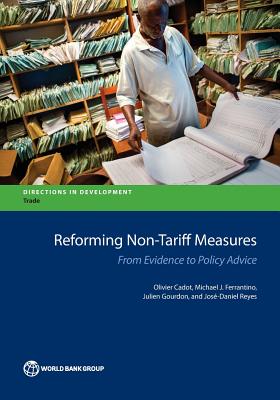| FindBook |
有 1 項符合
Reforming Non-Tariff Measures: From Evidence to Policy Advice的圖書 |
 |
Reforming Non-Tariff Measures: From Evidence to Policy Advice 作者:Cadot 出版社:World Bank 出版日期:2018-03-09 語言:英文 規格:平裝 / 17.8 x 26 x 1.3 cm / 普通級 |
| 圖書館借閱 |
| 國家圖書館 | 全國圖書書目資訊網 | 國立公共資訊圖書館 | 電子書服務平台 | MetaCat 跨館整合查詢 |
| 臺北市立圖書館 | 新北市立圖書館 | 基隆市公共圖書館 | 桃園市立圖書館 | 新竹縣公共圖書館 |
| 苗栗縣立圖書館 | 臺中市立圖書館 | 彰化縣公共圖書館 | 南投縣文化局 | 雲林縣公共圖書館 |
| 嘉義縣圖書館 | 臺南市立圖書館 | 高雄市立圖書館 | 屏東縣公共圖書館 | 宜蘭縣公共圖書館 |
| 花蓮縣文化局 | 臺東縣文化處 |
|
|
圖書介紹 - 資料來源:博客來 評分:
圖書名稱:Reforming Non-Tariff Measures: From Evidence to Policy Advice
內容簡介
High levels of trade costs persist in the world trading system, despite recent progress in tariff reduction, trade facilitation, and logistics. At least some of these costs can be attributed to non-tariff measures (NTMs), policies imposed by governments other than ordinary customs duties which have an impact on the price at which exports and imports are traded, the quantities traded, or both. Such costs are particularly worrisome if they have a discriminatory or protectionist effect, or violate countries’ international commitments. However, even NTMs designed to carry out domestic regulatory objectives – for example, protection of human, animal or plant health, consumer or workplace safety, or the environment – can have substantial effects on international trade, which should be considered when such policies are developed.This book discusses some of the analytical methods that can be used to accompany the process of policy development for NTMs. It discusses the broad economic rationale for improving the design of NTMs;, illustrates the main forms of quantification of NTMs and their effects, including inventory approaches, price-based approaches, and quantity-based approaches; proposes a new analytical and measurable concept of “regulatory distance” to help guide deep integration efforts at the regional level; provides a discussion of the effects of NTMs on household expenditures, poverty, and firm competitiveness; and shows how empirical analysis of NTMs can be used to inform policy advice. As such, it should provide a valuable addition to the arsenal of tools available for applied analysis of international trade policy.
|











